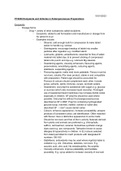15/01/2023
PY4030 Excipients and Vehicles in Extemporaneous Preparations
Excipients
- Dosage forms
- Drug + variety of other substances called excipients
- Excipients: added to aid formulation and manufacture or dosage form
for admin’tn to pt
- Examples include:
- Diluents: add enough bulk for compression & make tablet
easier to handle e.g. lactose
- Disintegrants: encourage breakup of tablet into smaller
particles after ingestion e.g. modified starch
- Lubricants, glidants, antiadherents: essential for flow of tablet
material into tablet dye, & to prevent sticking of compressed
tablet onto punch and dye e.g. lubricant Mg stearate
- Sweetening agents, viscosity enhancers, flavouring agents,
preservatives, emulsifying agents, colouring agents,
stabilisers, suspending agents
- Flavouring agents: make med more palatable. Flavour must be
non-toxic, soluble if for clear product, stable in and compatible
with preparation. Patient age should be accounted for.
Flavours & colours should complement each other. Include
juices, extracts, spirits, tinctures, syrups, aromatic waters
- Sweeteners: oral prep’tns sweetened with sugars e.g. glucose
or sucrose (which also increases liquid viscosity). Prolonged
use of sweetened liquid medicines may increase dental caries
especially in children. SF prep’tns should be used where
possible. Oral prep’tns without fructose/glucose/sucrose
described as SF in BNF. Prep’tns containing hydrogenated
glucose syrup, mannitol, maltilol, sorbitol or xylitol also
described SF → don’t cause dental caries
- Colours: enhance appearance, increase acceptability, prepare
products of consistent colour, aid identification. Often matched
with flavour. Give a distinctive appearance to some meds.
Should be non-toxic and free of ther’c activity. Naturals derived
from plants and animals are preferred e.g. chlorophylls,
saffron, red beetroot, caramel. Sometimes synthetic orange
dyes used e.g. azo compounds. Tartrazine known to cause
allergies & hyperactivity in children. In EU colours selected
from listed permitted for med’l products with designated E
numbers 100-180
- Stabillisers: antioxidants may be used where ingrdnts liable to
oxidation e.g. oils. Odourless, tasteless, non-toxic. E.g.
ascorbic acid, citric acid, Na metabisulphite, Na sulphite
- Viscosity enhancers: improve palatability and facilitate
pourability. E.g. syrup added to increase viscosity of oral soln





